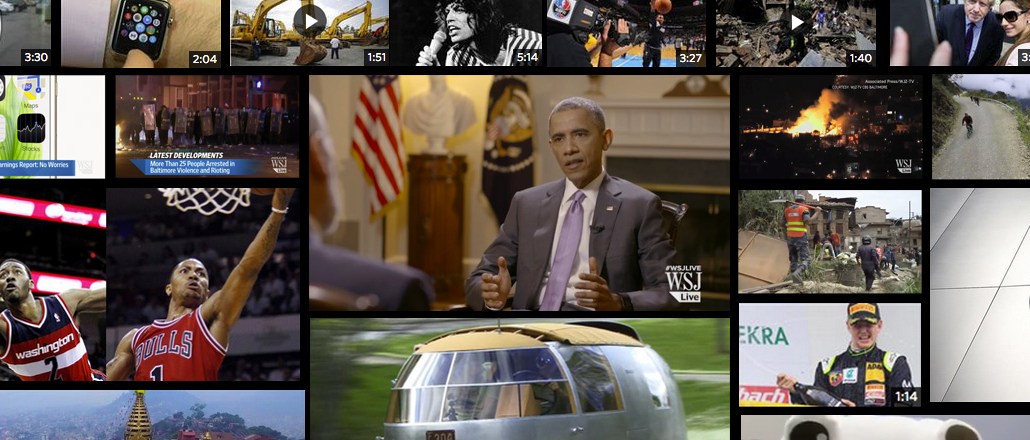
The Wall Street Journal is zealous about protecting its paywall, and with good reason — circulation revenue contributes nearly half of its total revenue, fueled by more than 900,000 digital subscribers. But with video, the Journal takes a broader view.
Advertiser demand for digital video is still strong, so publishers like the Journal (estimated to charge CPMs in the range of $50 to $75) are incentivized to get as many views as possible. So video sits in front of the paywall. Beyond that, the Journal also has been tweaking its formula to maximize the number of video views it gets. On the eve of its third NewFronts presentation, Andy Regal, senior executive producer for video at the Journal, shared how the publisher is making video work while staying true to its journalism and business goals.
Promotion on site
One big change is promotion. The Journal has about 40 full-time people dedicated to video and produces about 30 to 40 videos a day. The Journal has been getting about 6 million monthly video views on site over the past year, according to comScore (which doesn’t measure mobile video yet). But it trails archrival The New York Times, which has 75 full-time video staff and 18 million monthly video views by the end of 2014, up from 11 million in the beginning of the year.
People don’t necessarily come to the Journal looking for video as much as they are to get caught up on the news. Hence the Journal has been putting more video at the top of news stories. The site was redesigned last week, and video is getting more play on the homepage, with a bigger video player and a top-five videos module. “Even today, it’s not easy to get people to click on video, especially with the stories we’re covering, which are not always going to be llamas and Academy Awards dresses,” Regal said.
Graphic treatment
News publishers have constraints that others don’t. Their traffic is, to a large extent, a function of the news cycle. News often isn’t visual in nature, so they don’t lend themselves to the video format. So the Journal has been trying to inject more graphics in videos to tell non-visual stories.
Ad position: web_incontent_pos1
Interactive video
The Journal has also moved into interactive videos, like “Academy Awards: What to Watch for on Oscars Night” and “These YouTubers Get to Interview Obama About #SOTU.” These videos keep people on site longer by giving them other things to do while watching the video, such as read a story, sample infographics and read associated comments on Facebook and Twitter.
Keep it short
Getting shares is a way to get viewers to do your promotional work for you, so the Journal has been emphasizing shorter videos because it has found they’re more likely to be watched to the end and shared. The average video length is three minutes or less.
Platform plays
The rise of platforms has publishers trying to figure out how much of their content they should put on social media, where they can reach new audiences. While other publishers take the view that they need to be wherever the audience is, the Journal takes a more conservative stance. The WSJ uses 32 video-distribution partners including YouTube, AOL and even Apple TV, and it’s creating shorter-form video for the social networks including Facebook (see example below), Vine and Twitter, but it sees the primary focus of those as getting people to come to WSJ.com.
Ready for a wild ride? Explore 21 years of the Nasdaq with our virtual reality roller coaster tour, available on desktop, mobile, and 3D VR: http://on.wsj.com/1aYbgpT
Ad rendering preventing in staging
Ad position: web_incontent_pos2Posted by The Wall Street Journal on Friday, April 24, 2015
“You can’t conduct Wall Street Journal journalism in 15 to 20 seconds,” Regal said. “We’re thrilled to get our video out to a broader audience. But our real focus is driving as much traffic as possible to our WSJ.com platform. When it’s on your platform, you keep 100 percent of the revenue.”
Image courtesy of WSJ.com.
More in Media

NewFronts Briefing: Samsung, Condé Nast, Roku focus presentations on new ad formats and category-specific inventory
Day two of IAB’s NewFronts featured presentations from Samsung, Condé Nast and Roku, highlighting new partnerships, ad formats and inventory, as well as new AI capabilities.

The Athletic to raise ad prices as it paces to hit 3 million newsletter subscribers
The New York Times’ sports site The Athletic is about to hit 3 million total newsletter subscribers. It plans to raise ad prices as as a result of this nearly 20% year over year increase.

NewFronts Briefing: Google, Vizio and news publishers pitch marketers with new ad offerings and range of content categories
Day one of the 2024 IAB NewFronts featured presentations from Google and Vizio, as well as a spotlight on news publishers.
Ad position: web_bfu